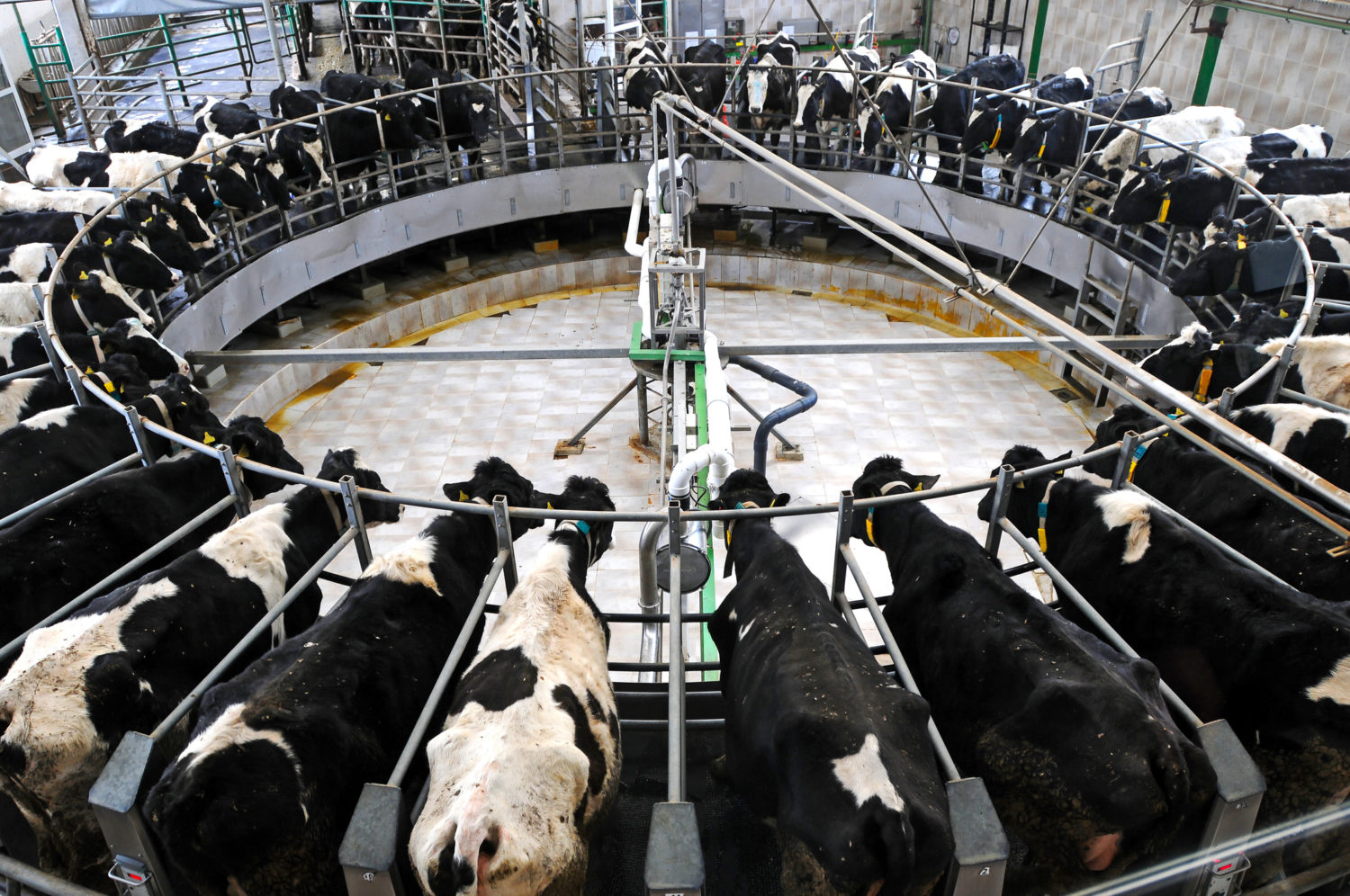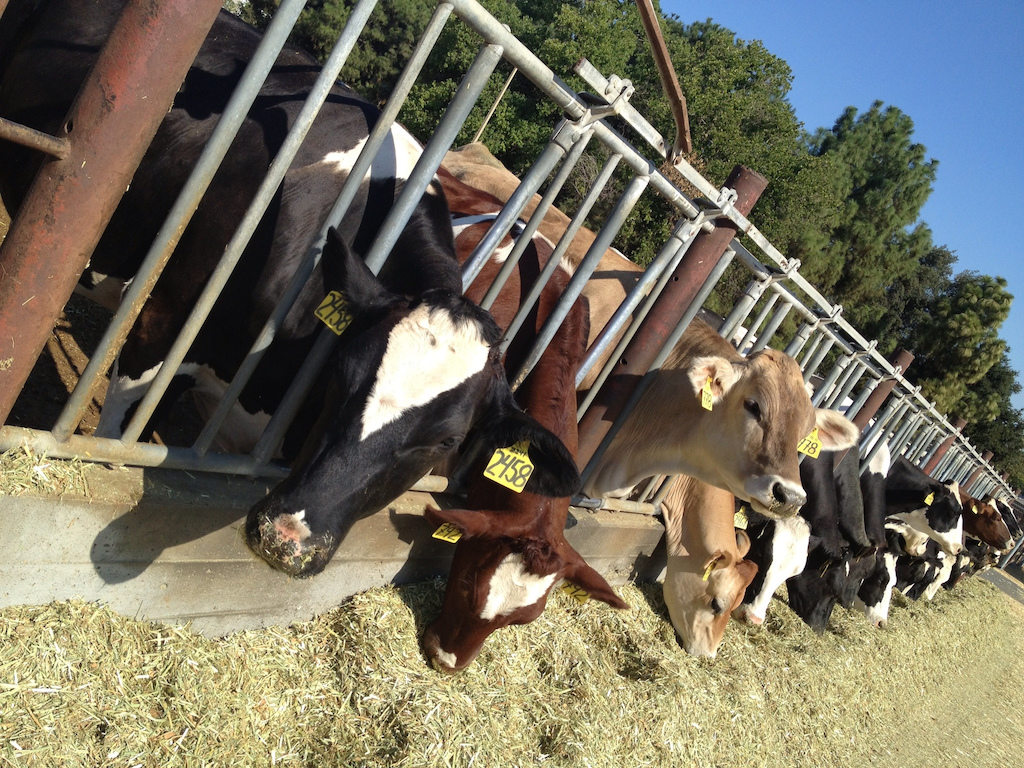New Food Economy: Why sick dairy cows may be the culprit in last week’s historic Salmonella beef recall
by Joe Fassler | October 9th, 2018
Since the mid-1980s, scientists have identified dairy cows as the primary reservoir of Salmonella Newport. A closer look at established facts points to an ongoing food safety crisis hidden in plain sight.
Late last week, JBS, the world’s largest meatpacker, recalled 6.9 million pounds of ground beef that it said may have been tainted with Salmonella Newport. Here’s what we know four days into the recall: the strain is responsible for sickening 57 people in 16 states. All of the meat came from the same JBS plant in Tolleson, Arizona. And in less than a week, the incident has already reached historic proportions. It’s the largest recall of beef since the notorious Rancho Feeding Inc. recall of 2014. Former USDA food safety specialist Carl Custer has said it’s largest-ever recall of ground beef related to Salmonella.
Still, major questions remain. The United States Department of Agriculture’s Food Safety and Inspection Service (FSIS) may again broaden the scope of the recall, as it already did on Thursday. More stores may be added to the list of affected retailers published over the weekend. And, of course, more Americans may continue to fall ill. But while basic facts—how much meat, from which stores, causing how many illnesses—remain unclear, a larger uncertainty looms. Namely: How does nearly 7 million pounds of beef get exposed to Salmonella in the first place, then get shipped out to the public? What, exactly, went wrong at Tolleson?
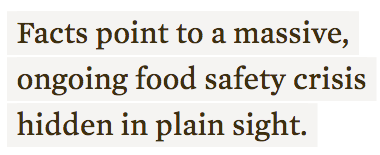 When I asked FSIS for additional insight, I was told I’d have to file a Freedom of Information Act (FOIA) request to learn more. JBS did not respond to multiple requests for comment. So far as the official channels are concerned, we’re still largely in the dark.
When I asked FSIS for additional insight, I was told I’d have to file a Freedom of Information Act (FOIA) request to learn more. JBS did not respond to multiple requests for comment. So far as the official channels are concerned, we’re still largely in the dark.
And yet, the few details voluntarily released are very revealing if you read between the lines, helping to explain why the meat of an estimated 13,000 animals, a small city of cattle, is now headed for the landfill.
The people I spoke to for this story suggest this outbreak had a clear origin point: a dairy farm in the Southwest. That’s important, because dairy cows processed for meat turn out to be a kind of food safety blind spot. For reasons I’ll explain, dairy cows sickened by Salmonella are more likely than healthy ones to be sent to meat plants for slaughter. Once there, they’re likely to be ground up and used as filler in thousands of pounds of beef, dramatically increasing their risk potential. Perhaps most surprisingly, there’s no system in place to track or disarm this risk. In fact, thanks to a quirk in food safety law, meatpackers aren’t required to test for Salmonella. And even when it is present, the government can’t really do anything about it—not even if millions of pounds of tainted product are at stake.
While we may never know the exact details of this outbreak, we can look to previous recalls for clues—and established facts point to a massive, ongoing food safety crisis hidden in plain sight.
Tolleson, Arizona, situated just west of the Phoenix metropolitan area, is surrounded by cows.
Arizona is the 13th highest milk-producing state by volume. Neighboring New Mexico, with 323,000 cows producing more than 8 billion pounds of milk in 2017, ranks in the top ten. But in the realm of livestock transport, where farmers routinely have to drive their animals hundreds of miles to be slaughtered, Tolleson is less than a day’s drive from the country’s most productive dairy region: central and Southern California.
California is by far the largest milk-producing state in the nation. In San Bernardino County alone, 40,000 dairy cows produced almost a billion pounds of milk in 2017. Heading north from there into lusher, more temperate central California, production only increases. The state’s top five milk-producing counties—Tulare, Merced, Kings, Stanislaus, and Kern—are home to well over a million dairy cows, who churned out about 27 billion pounds of milk in 2017.
The dairy industry’s proximity is a corroborating detail in last week’s recall. But location isn’t the only factor that makes dairy cows the likely culprit. The smoking gun here is epidemiological: Salmonella enterica serotype Newport, the unusual strain of Salmonella implicated in this recall, has been highly linked to dairy cows in the past. In fact, since the mid-1980s, scientists have identified dairy cows as the primary reservoir of Salmonella Newport.
In 1985, Californians in Los Angeles County started getting sick. Further research found that Salmonella Newport was to blame—a specific, multi-drug-resistant strain that came from California dairy farms. Scientists found that same unique strain in ground beef products on the shelf, at the slaughterhouse where those products were processed, at the dairies who’d sent cows for slaughter on the days tainted product was pushed through, and in the bodies of sick cows at those dairies. In the years that followed, the research community began to take note.
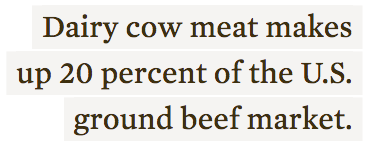 “Dairy cows have been incriminated as the source of Salmonella Newport-contaminated hamburgers causing foodborne illness,” wrote the authors of a 1997 paper published by the World Organization for Animal Health, an intergovernmental organization that works to control animal disease worldwide. By 2002, after several smaller outbreaks, researchers from the Centers for Disease Control (CDC) acknowledged that “strains of Salmonella enterica serotype Newport are becoming increasingly common in dairy cattle and are causing a growing share of infections in humans.”
“Dairy cows have been incriminated as the source of Salmonella Newport-contaminated hamburgers causing foodborne illness,” wrote the authors of a 1997 paper published by the World Organization for Animal Health, an intergovernmental organization that works to control animal disease worldwide. By 2002, after several smaller outbreaks, researchers from the Centers for Disease Control (CDC) acknowledged that “strains of Salmonella enterica serotype Newport are becoming increasingly common in dairy cattle and are causing a growing share of infections in humans.”
Last year, Megin Nichols, a CDC veterinarian, was part of a team of scientists tasked with investigating a recall that had close similarities to JBS’s: Between October 2016 and July 2017, 106 people across 21 states were sickened by Salmonella Newport after eating ground beef. Nichols’s team traced this lesser-known strain of salmonella back to a herd of New Mexico dairy cows.
Based on the strain detected, dairy cows are the likely source of this year’s outbreak, too, she says.
In other words, experts seem to agree that whenever Salmonella Newport turns up in ground beef—the exact scenario that lead to last week’s recall—dairy cows tend to be the culprit. I was not able to find reference to a Salmonella Newport outbreak linked to ground beef that didn’t originate with dairy cows. And so it seems reasonable to conclude, even though JBS and FSIS have not offered more official information, that this outbreak is no different, especially given the plant’s proximity to dairy country.
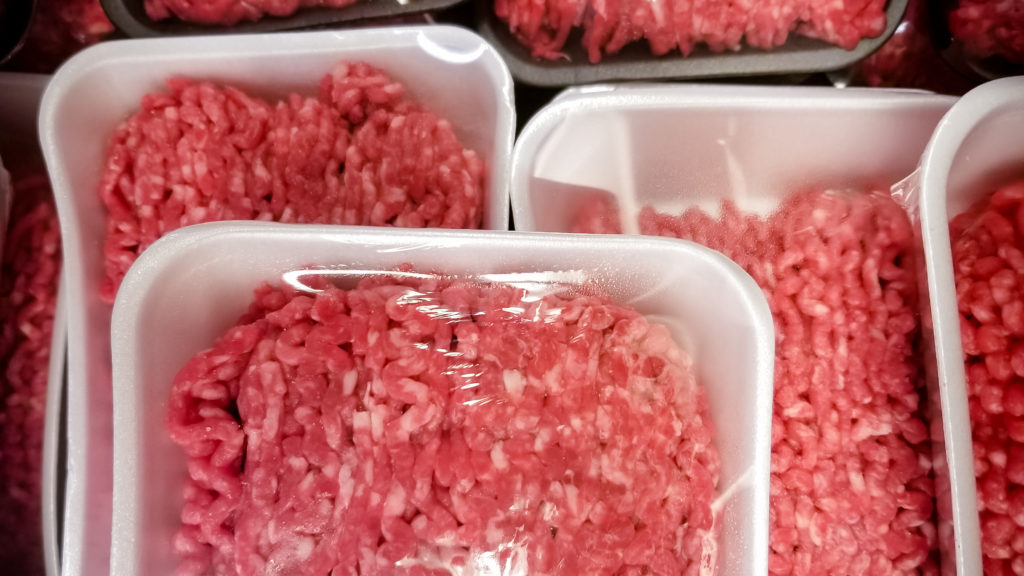
iStock / AHPhotoswpg
Between October 2016 and July 2017, 106 people were sickened by Salmonella Newport after eating ground beef linked to dairy cows
But how does Salmonella Newport get into dairy cows in the first place, and why is that strain so likely to end up in our hamburgers? This part of the story that has to do with biology, economics, and regulation—and it’s where things start to get very interesting.
At large-scale, intensive dairies like the ones that proliferate in California, productivity is all-important. Cows are hooked up by their udders to pneumatic sucking devices and placed on “rotary milking parlours,” originally called Rotolactors—a slowly turning wheel of automated milking stalls, kind of like a cow Gravitron. To best earn a living, dairy farmers need to make sure every cow on that wheel is as productive as physically possible. So when a cow’s output significantly drops for any reason, the farmer must make the difficult decision about whether or not to “cull” the cow: to sell it for meat, and find a better-producing replacement to take its place.
Culling is an unfortunate reality of dairy production. Virtually all dairy cows are sold for meat at some point, but farmers never want to sell a cow they’ve invested time, money, and effort in until they really have to. The difficult question farmers continually face is whether it would be cheaper and more efficient to treat a cow’s ailment, losing productivity all the while, or just sell it for meat and replace it.
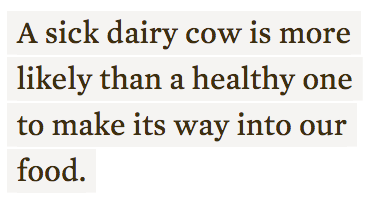 Routinely, culling makes the most sense. A 2007 USDA report found that roughly a quarter of cows are removed from dairies each year for one reason or another, and that the vast majority of culled cows are sold for meat. That makes for a lot of burgers. Since dairy cows are bred for milking, not for well-marbled steaks, they’re typically ground, not processed into primal cuts. All that dairy cow meat makes up a significant proportion of the U.S. ground beef market—about 20 percent, according to the Cattlemen’s Beef Board.
Routinely, culling makes the most sense. A 2007 USDA report found that roughly a quarter of cows are removed from dairies each year for one reason or another, and that the vast majority of culled cows are sold for meat. That makes for a lot of burgers. Since dairy cows are bred for milking, not for well-marbled steaks, they’re typically ground, not processed into primal cuts. All that dairy cow meat makes up a significant proportion of the U.S. ground beef market—about 20 percent, according to the Cattlemen’s Beef Board.
That’s where Salmonella comes in. Because when cows get Salmonella—and Salmonella Newport in particular—their milk output starts to drop. This helps explains a contorted fact that’s hard to believe: A sick dairy cow is more likely than a healthy one to make its way into our food.
Salmonella bacteria can get into a dairy herd in a variety of ways. It can be introduced by new replacement cattle carrying it, or brought in by the rodents or wild birds attracted to grain-heavy dairy cow feed. Because of the stress of modern dairies, cows tend to be quite susceptible to these germs, especially as they age.
“If you can imagine dairy cow environments, there’s a lot of cows, often moving around in a contained space,” says CDC’s Megan Nichols. “One of the things that might really predispose [dairy cows] to infections are some of the environmental factors and just being mixed with hundreds of other cows. I think anytime you bring a large group together, whether it’s a group of people or a herd of cattle, you’re potentially introducing new diseases.”
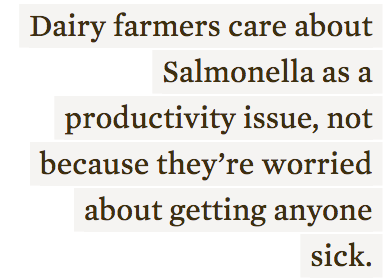 As a result, dairy cattle do frequently harbor Salmonella—though estimates vary widely on how often. A 1994 survey in Washington state found Salmonella in only 4.6 percent of culled dairy cattle. More recently, a 2012 study of dairies on the Texas High Plains found Salmonella in nearly a third—32.6 percent—of culled dairy cows from nine different operations. Research at dairies in New York state found that individual farms ranged dramatically: In some dairy herds, zero percent of cows tested positive for Salmonella, while others tested positive at rates as high as 53 percent. USDA data tell us that over 50 percent of dairies with more than 500 cows are Salmonella-positive, more than half of them clustered in the West and Southwest.
As a result, dairy cattle do frequently harbor Salmonella—though estimates vary widely on how often. A 1994 survey in Washington state found Salmonella in only 4.6 percent of culled dairy cattle. More recently, a 2012 study of dairies on the Texas High Plains found Salmonella in nearly a third—32.6 percent—of culled dairy cows from nine different operations. Research at dairies in New York state found that individual farms ranged dramatically: In some dairy herds, zero percent of cows tested positive for Salmonella, while others tested positive at rates as high as 53 percent. USDA data tell us that over 50 percent of dairies with more than 500 cows are Salmonella-positive, more than half of them clustered in the West and Southwest.
Why isn’t it a bigger deal that Salmonella is so prevalent at large diaries? The dairy industry would argue that Salmonella isn’t really a public health issue, thanks to the miracles of modern milk processing. Since proper pasteurization will kill a range of bacteria including Salmonella, you could argue that it doesn’t really matter if a cow is carrying it or not. Dairy farmers care a lot about Salmonella, but that’s in part because it’s a productivity issue that affects their bottom line.
In fact, dairy farmers may not ever know their cows have Salmonella. Though acute cases can result in a range of noticeable symptoms in cows, including fever, diarrhea, and death, most cases of dairy cow Salmonella are subclinical—they betray no obvious signs. “Subclinical Salmonella may be lurking in your herd, and you’d never know it,” warns a promotional pamphlet published by Zoetis, the world’s largest producer of animal medications. According to Zoetis’s guide, the main thing farmers are likely to notice is a drop in milk production—about 2.5 pounds of milk per infected animal per day, which adds up to more than a ton of milk per week at a heavily infected 500-cow dairy.
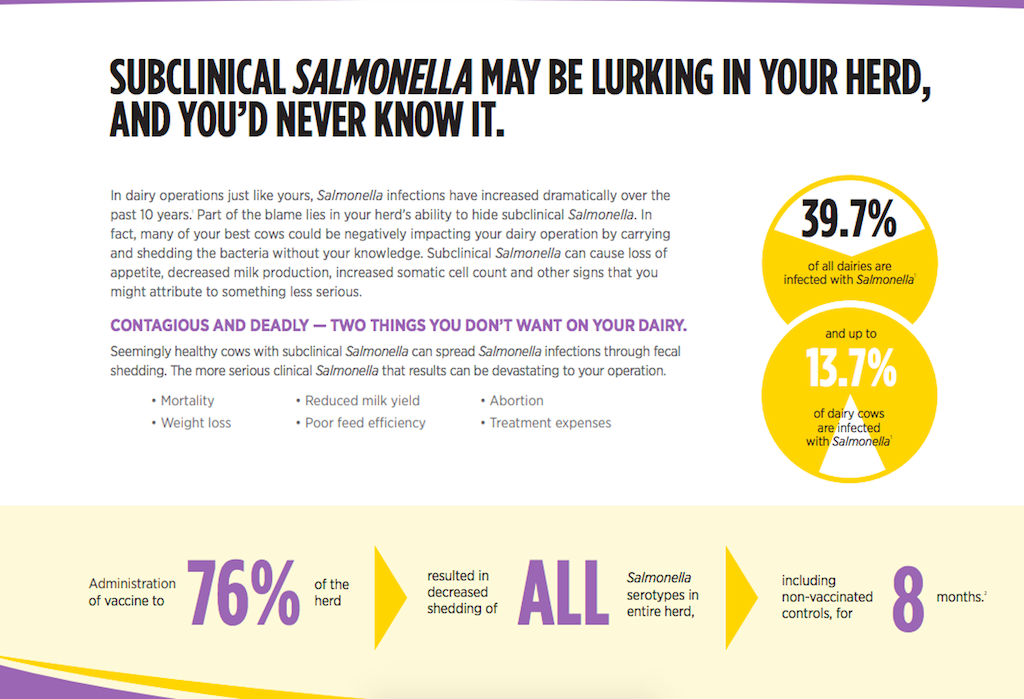
Zoetis
A pamphlet by Zoetis, the world’s largest producer of animal medications, warns of the dangers of “hidden” salmonella in a dairy cow herd
Salmonella Newport can can also cause what veterinarians call an “abortion storm”—a rash of cows in a herd suffering spontaneous abortion. Cows who suffer an abortion can’t produce milk for the season—enough incentive for farmers, hard-pressed to feed and house and animals that can’t produce, to send them to slaughter. But even cows that see a mild to moderate drop in production are likely to be pulled from the herd. In this way, a strange kind of logic plays out across the industry: The sicker an animal is, the more likely it is to enter the food supply. Because when cows stop producing milk for any reason—whether it’s due to age, stress, or disease—we usually end up eating them.
When infected dairy cows leave the herd, they take their Salmonella with them. Animals processed at the large plants like the one in Tolleson often travel hundreds of miles to get there, a stressful, crowded journey that makes them more likely to both contract and spread illness. Finally, at the slaughterhouse, the Salmonella that isn’t really a health risk on dairy farms suddenly becomes one. Because meat isn’t pasteurized like milk, after all. Plenty of Americans like their burgers medium-rare.
If dairy cows are more likely than beef cattle to harbor Salmonella, the way they’re processed at slaughterhouses makes them even more likely to spread it. While beef cattle are typically processed in “lots”—cattle of specific types, whether conventional, organic, or 100-percent grass fed are kept separate by attribute and price—dairy cows are blended into a wide spectrum of products. You won’t eat a burger that is all dairy cow; those animals aren’t really raised for meat. Culled dairy cows are frequently used as a kind of padding ingredient that’s mixed in with standard beef.
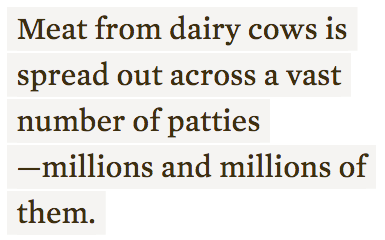 “Lean beef trimmings from cull cows are often blended with high-fat content beef trimmings harvested from animals finished in feedlots to facilitate a consistent supply of ground beef that meets certain purchase specifications,” according to a 2012 study published in the journal Foodborne Pathogens and Disease. (The study’s lead author is Guy Loneragan, a Texas Tech University food scientist who tells me he also has a paid role on JBS’s Food Safety and Quality Team.) “As a consequence, beef from culled dairy cows may be broadly incorporated into ground beef products across the United States.”
“Lean beef trimmings from cull cows are often blended with high-fat content beef trimmings harvested from animals finished in feedlots to facilitate a consistent supply of ground beef that meets certain purchase specifications,” according to a 2012 study published in the journal Foodborne Pathogens and Disease. (The study’s lead author is Guy Loneragan, a Texas Tech University food scientist who tells me he also has a paid role on JBS’s Food Safety and Quality Team.) “As a consequence, beef from culled dairy cows may be broadly incorporated into ground beef products across the United States.”
In other words, meat from dairy cows is spread out across a vast number of patties—millions and millions of them. That’s not a bad thing when the meat doesn’t harbor Salmonella. But when it does, the results can be dramatic. The JBS recall ordered by FSIS affected 49 different JBS product lines, from its Cedar River Farms “natural” beef, to its Grass Run Farms line of grass-fed beef, to its conventional beef sold under Walmart’s “Showcase” label. One reason why FSIS recalled so many different products, and so much meat overall, could be that each of these individual offerings was blended with potentially tainted dairy cow meat.
For more conventional offerings, blending with dairy cow trim is standard and would be unsurprising. But in the case of specialty beef marketed with claims like “100 percent grass-fed,” that’s really not supposed to happen. Was that what went on at Tolleson? Hard to say, because there’s another possibility, too: that only some of JBS’s products were blended with the unsafe beef, but pathogens remained inside processing equipment due to a sanitation issue. In other words, dirty equipment may also have contributed to the problem.
“When you have a six-week window where you have many, many different types of products implicated, it appears to be a sanitation issue,” says Angela Anandappa, founding director at the Alliance for Advanced Sanitation, and a research assistant professor with the Department of Food Science and Technology at the University of Nebraska, Lincoln. She points out a full cleaning must take place every 24 hours for slaughter and ground beef operations. “If equipment wasn’t adequately cleaned, Salmonella could haven taken up residence. That’s very possible here.”
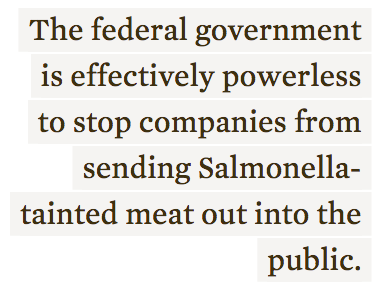 FSIS confirmed to me that “processing equipment must be broken down, cleaned and sanitized in between production days,” according to federal regulations. It’s possible that didn’t happen here. But you’d also think that JBS would be testing constantly for signs of virulent pathogens like Salmonella Newport—and if the company had taken the time to look, they would have been able to stop the outbreak in its tracks. After all, we’re talking about millions of pounds of meat that moved through the plant over the course of six weeks. Who would want to risk a recall on that scale? Isn’t constant, stringent safety testing in place to prevent this very thing from happening?
FSIS confirmed to me that “processing equipment must be broken down, cleaned and sanitized in between production days,” according to federal regulations. It’s possible that didn’t happen here. But you’d also think that JBS would be testing constantly for signs of virulent pathogens like Salmonella Newport—and if the company had taken the time to look, they would have been able to stop the outbreak in its tracks. After all, we’re talking about millions of pounds of meat that moved through the plant over the course of six weeks. Who would want to risk a recall on that scale? Isn’t constant, stringent safety testing in place to prevent this very thing from happening?
No, actually—and that’s where things get really hard to stomach. According to USDA rules, Salmonella doesn’t even qualify as an “adulterant” in meat. That means processors aren’t required to test for it. And if it does show up, it doesn’t mean they’re doing anything wrong—technically or legally.
“Presence of Salmonella in meat products does not render them injurious to health,’ and thus “adulterated” per se within meaning of the Federal Meat Inspection Act (FMIA), as normal cooking practices destroy Salmonella organism,” writes the legal research firm Westlaw. In practice, that means that the federal government is effectively powerless to stop companies from sending Salmonella-tainted meat out into the public.
Case in point: In 2011, FSIS pulled its inspectors and halted production at Supreme Beef, Inc., a Texas processor who was selling Salmonella-tainted ground beef to the state’s public school system. Supreme sued, arguing that the presence of Salmonella was not cause for the government to intervene. Ultimately, the United States Court of Appeals agreed, writing that “cross-contamination of Salmonella alone cannot form the basis of a determination that a plant’s products are adulterated, because Salmonella itself does not render a product ‘injurious to health.’”
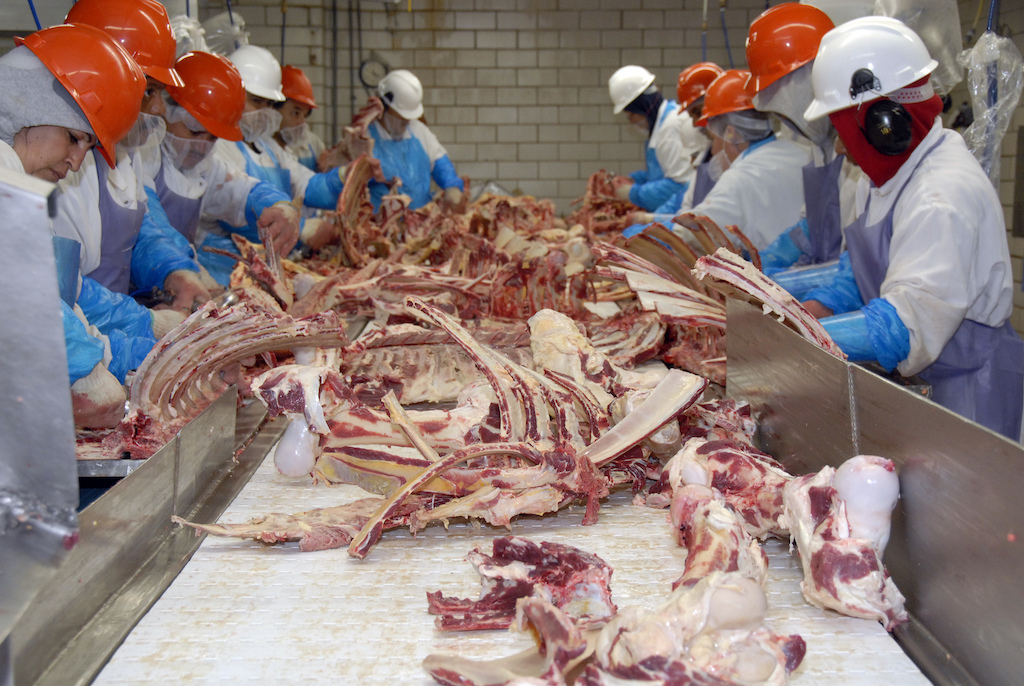
Flickr / USDA
Workers at a Texas slaughterhouse, where FSIS inspectors are on hand to ensure meat meets USDA food safety standards. But FSIS can do little to regulate the presence of Salmonella in meat
The presence of Salmonella in meat, then, poses no public safety hazard—at least by any legal definition. Even if Salmonella-tainted product actually starts making people sick, the government has no legal recourse to force a company to recall it, or to punish a company for distributing it in the first place. JBS’s recall of 7 million pounds of beef was entirely voluntary, after all—issued not because the government forced its hand, but because the company thought it was a good idea.
“Technically, JBS could have said to FSIS, ‘Forget it, I’m not recalling the product,’” says Bill Marler, food safety lawyer and publisher of the website Food Safety News. “Now, that would not have been a smart move on their part because I can still sue them under state law and collect damages. Or if some little kid gets sick or dies, that would not be a good thing from their perspective.” But companies don’t really have to issue meat recalls for Salmonella, —even though they do for E. coli.
According to Marler, E. coli and Salmonella have had radically divergent public health histories. After the 1993 Jack in the Box outbreak that sickened hundreds and killed four (at least three of them children), FSIS moved to make E. Coli an adulterant under FMIA, making it illegal in commerce. As a result, meat processors must test for E. coli, and if it’s found to be present in meat, they can’t sell it. In the wake of that decision, poisonings from E. coli 0157:H7—the most dangerous strain—have fallen by 40 percent since 1994.
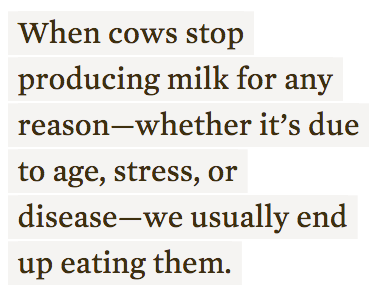 But Salmonella has taken a different path: Its noxious impact has continued unabated. According to CDC, Salmonella is still responsible for 1. 2 million illnesses and 450 deaths every year—and the rate of confirmed cases has held steady.
But Salmonella has taken a different path: Its noxious impact has continued unabated. According to CDC, Salmonella is still responsible for 1. 2 million illnesses and 450 deaths every year—and the rate of confirmed cases has held steady.
The government’s lack of regulatory power over Salmonella shrouds the recent JBS recall in secrecy. Because it cannot be said that the company did anything wrong, USDA can’t insist on providing transparency to the public. Legally, JBS is only recalling potentially tainted beef because it wants to. As such, we may never know what really happened.
But that’s why the case I’ve laid out here, though speculative, is important. By reporting on each recall as a one-off, a crisis that’s here one day and gone the next, we fail to connect the larger dots in an increasingly clear picture. There are things we do know, after all. We know that Salmonella Newport has almost always been linked to dairy cows in the past. We know that those sick cows are more likely to be sold to meat plants than their healthy comrades. We know that dairy cow meat is typically treated like filler at the slaughterhouse, processed in a way that dramatically increases its already significant risks. And we know that, if there is a Salmonella-related food safety issue, the government can’t really do anything about it until it is too late.
There’s only one question that remains, really: why, knowing what we know, we don’t do more about it.
Additional reporting contributed by Sam Bloch.
